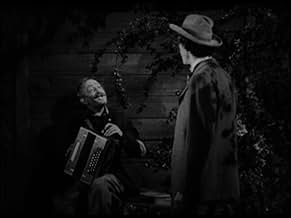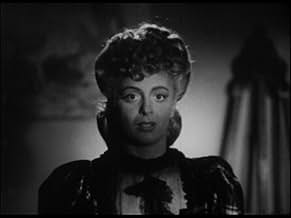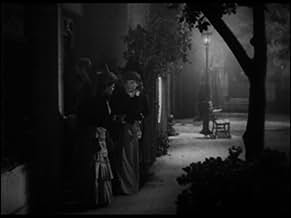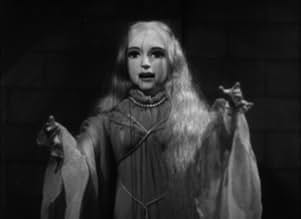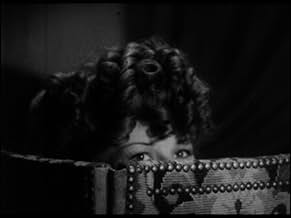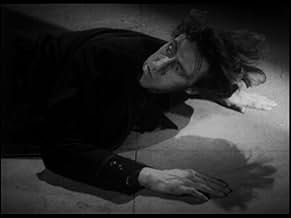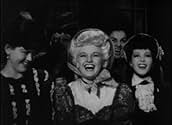VALUTAZIONE IMDb
5,9/10
2266
LA TUA VALUTAZIONE
A Parigi, un artista assume modelle e dopo aver finito i loro ritratti, le strangola.A Parigi, un artista assume modelle e dopo aver finito i loro ritratti, le strangola.A Parigi, un artista assume modelle e dopo aver finito i loro ritratti, le strangola.
- Regia
- Sceneggiatura
- Star
Ludwig Stössel
- Jean Lamarte
- (as Ludwig Stossel)
Harry Cording
- Policeman
- (non citato nei titoli originali)
Frank Darien
- Inquiry Judge
- (non citato nei titoli originali)
Bess Flowers
- Courtroom Spectator
- (non citato nei titoli originali)
Mabel Forrest
- Woman
- (partecipazione non confermata)
- (non citato nei titoli originali)
Eddie Hall
- Paul
- (non citato nei titoli originali)
Recensioni in evidenza
A PRC poverty row production that makes the most of its limited budget. A lot of credit should go to production designers Eugene Shufftan and Edgar Ulmer who collaborated on the movie's sumptuous look. Even when the middle part drags, the visuals remain arresting. Note too how the meagre exterior sets are stylized to make up for the limitations. Of course, cult director Ulmer was no stranger to transforming army surplus material into artistic effects. The overall result is an atmospheric recreation of 19th century Paris.
Making Carradine's Bluebeard a puppeteer is a novel and interesting wrinkle. Then too, I can't help thinking there is more plot potential in continuing with Bluebeard the puppet master than in shifting the story line over to Bluebeard the painter, as the screenplay does. Nonetheless, those early scenes in the park are good ones. However, the cadaverous actor who can be as florid and intense as anyone seems a little too understated here. While physically he looks the part of the grim reaper, Carradine is simply no good as a simpering lover, while too many of his scenes lack the menace the role calls for. Unfortunately, the result compares unfavorably, for example, with Laird Cregar's riveting Jack the Ripper in that Gothic thriller The Lodger of the same year. It appears Ulmer is much more the visual artist than the thespic coach.
Nonetheless, the movie remains an interesting curiosity. Consider the sheer wackiness of presenting Iris Adrian whose cheap Brooklyn accent can barely be disguised as a Parisian. Still, it does amount to an amusing turn. Also, note the off-angle camera staging of Carradine's flashback sequence, which is both effective in identifying the sequence and artfully composed. Such camera effects were hardly a Hollywood staple at a time when producers generally felt they would confuse the audience.
Of course, there's the question that always arises for fans of Ulmer. What would he have done with an A-budget and A-material in a career spent in the lower depths of Hollywood production. Hard to say-- perhaps he needed the challenge of PRC-type constraints. However, I think it's fair to say that none of his poverty row productions are without genuine points of interest and entertainment, and-- as is the case with Bluebeard-- may even rise at times to artistic levels.
Making Carradine's Bluebeard a puppeteer is a novel and interesting wrinkle. Then too, I can't help thinking there is more plot potential in continuing with Bluebeard the puppet master than in shifting the story line over to Bluebeard the painter, as the screenplay does. Nonetheless, those early scenes in the park are good ones. However, the cadaverous actor who can be as florid and intense as anyone seems a little too understated here. While physically he looks the part of the grim reaper, Carradine is simply no good as a simpering lover, while too many of his scenes lack the menace the role calls for. Unfortunately, the result compares unfavorably, for example, with Laird Cregar's riveting Jack the Ripper in that Gothic thriller The Lodger of the same year. It appears Ulmer is much more the visual artist than the thespic coach.
Nonetheless, the movie remains an interesting curiosity. Consider the sheer wackiness of presenting Iris Adrian whose cheap Brooklyn accent can barely be disguised as a Parisian. Still, it does amount to an amusing turn. Also, note the off-angle camera staging of Carradine's flashback sequence, which is both effective in identifying the sequence and artfully composed. Such camera effects were hardly a Hollywood staple at a time when producers generally felt they would confuse the audience.
Of course, there's the question that always arises for fans of Ulmer. What would he have done with an A-budget and A-material in a career spent in the lower depths of Hollywood production. Hard to say-- perhaps he needed the challenge of PRC-type constraints. However, I think it's fair to say that none of his poverty row productions are without genuine points of interest and entertainment, and-- as is the case with Bluebeard-- may even rise at times to artistic levels.
When not playing featured roles in classics like 'The Grapes of Wrath' John Carradine made a good living in stuff right at the bottom of the heap. These were the films in which he actually enjoyed top billing, so not surprisingly it was one of them that gave him his personal favourite of his roles; seldom off the screen and at his most dashing.
Garrulous but stylish, director Edgar G. Ulmer again makes bricks without straw; it's one drawback being Leo Erdody's unrelenting score, although it's fun to hear him constantly plunder Mussorgsky.
Garrulous but stylish, director Edgar G. Ulmer again makes bricks without straw; it's one drawback being Leo Erdody's unrelenting score, although it's fun to hear him constantly plunder Mussorgsky.
This is a decent little film but more importantly it's a chance for the star (John Carradine) to show he COULD be a leading man and not just a cheesy supporting actor. In fact, I was THRILLED to see this film because only a couple weeks ago, I saw Carradine's worst film (BILLY THE KID VERSUS Dracula). This film helped to wash away the foul stench of failure from my mind--at least temporarily.
The film is, not surprisingly, a low-budget movie. Carradine played in many of these type of films but this one is different because it is actually well written, acted and engaging. And while it is NOT going to change your life by watching it, it does deliver excellent B-movie thrills.
The film is, not surprisingly, a low-budget movie. Carradine played in many of these type of films but this one is different because it is actually well written, acted and engaging. And while it is NOT going to change your life by watching it, it does deliver excellent B-movie thrills.
Over the years, there have been several notable versions dealing with the story of BLUEBEARD. The most critically acclaimed is Chaplin's MONSIEUR VERDOUX (1947). The most critically reviled is Richard Burton's BLUEBEARD from 1972. In 1960 George Sanders starred in BLUEBEARD'S 10 HONEYMOONS which is an effective, though hard to find, little B movie.
That has not been the case with PRC's BLUEBEARD (1944) starring John Carradine which has been available since the earliest days of TV. I first saw it in 1960 when I was 8. What has not been available, until now, is a decent print of the film. That has been corrected thanks to Kino Lorber with the release of this new Blu-ray.
PRC was known as the bottom rung of the "Poverty Row" ladder. Between 1939 and 1947 they cranked out an astonishing 179 films (that's 22 movies a year) which were shot in less than a week on a budget of less than $100K. Considering that, the look of their movies was very good but after numerous 16mm copies were used on TV, the visual and sonic quality sharply declined.
PRC's sound was never all that good to begin with and wear and tear on the prints made it even worse. I have seen BLUEBEARD many times and from a variety of sources but I have never seen a copy that looked and sounded this good and there are subtitles so at last you can understand what the puppets are singing.
Carradine (who was 38 at the time) gives his finest PRC performance as puppeteer Gaston Morell. He's low key and uses his baritone voice to great effect although that's obviously not him singing. For those who don't know, the opera is Gounod's FAUST. Director Edgar G. Ulmer loved classical music and worked it into his movies whenever he could. The other major theme comes from Mussorgsky's PICTURES AT AN EXHIBITION.
Other cast members include B movie queen Jean Parker as the heroine, former silent screen star Nils Asther as the Inspector, and Ludwig Stossel as the shady Art dealer. The film was photographed by Eugen Schufftan, the great German cameraman who did METROPOLIS, who was not credited due to Hollywood Union rules. The photography and the sets were supervised by director Ulmer.
In 19th century Paris, strangled woman are found floating in the Seine. The police have no clue. Could it be the kindly puppeteer who gives performances in the park? BLUEBEARD is not a horror film nor a mystery but rather a portrait of a tortured but compulsive killer whom we know will get caught in the end. It's the look of the film and Carradine's performance rather than the story that matters.
After years of bouncing around between various owners since PRC went under, BLUEBEARD now belongs to Paramount who has the resources to make it look and sound s good as it does on this Blu-ray. This is really the only way to see this movie. As more and more people are rediscovering the joys of physical media, this Kino Lorber disc is a must for any fan of 1940s B movie horrors...For more reviews visit The Capsule Critic.
That has not been the case with PRC's BLUEBEARD (1944) starring John Carradine which has been available since the earliest days of TV. I first saw it in 1960 when I was 8. What has not been available, until now, is a decent print of the film. That has been corrected thanks to Kino Lorber with the release of this new Blu-ray.
PRC was known as the bottom rung of the "Poverty Row" ladder. Between 1939 and 1947 they cranked out an astonishing 179 films (that's 22 movies a year) which were shot in less than a week on a budget of less than $100K. Considering that, the look of their movies was very good but after numerous 16mm copies were used on TV, the visual and sonic quality sharply declined.
PRC's sound was never all that good to begin with and wear and tear on the prints made it even worse. I have seen BLUEBEARD many times and from a variety of sources but I have never seen a copy that looked and sounded this good and there are subtitles so at last you can understand what the puppets are singing.
Carradine (who was 38 at the time) gives his finest PRC performance as puppeteer Gaston Morell. He's low key and uses his baritone voice to great effect although that's obviously not him singing. For those who don't know, the opera is Gounod's FAUST. Director Edgar G. Ulmer loved classical music and worked it into his movies whenever he could. The other major theme comes from Mussorgsky's PICTURES AT AN EXHIBITION.
Other cast members include B movie queen Jean Parker as the heroine, former silent screen star Nils Asther as the Inspector, and Ludwig Stossel as the shady Art dealer. The film was photographed by Eugen Schufftan, the great German cameraman who did METROPOLIS, who was not credited due to Hollywood Union rules. The photography and the sets were supervised by director Ulmer.
In 19th century Paris, strangled woman are found floating in the Seine. The police have no clue. Could it be the kindly puppeteer who gives performances in the park? BLUEBEARD is not a horror film nor a mystery but rather a portrait of a tortured but compulsive killer whom we know will get caught in the end. It's the look of the film and Carradine's performance rather than the story that matters.
After years of bouncing around between various owners since PRC went under, BLUEBEARD now belongs to Paramount who has the resources to make it look and sound s good as it does on this Blu-ray. This is really the only way to see this movie. As more and more people are rediscovering the joys of physical media, this Kino Lorber disc is a must for any fan of 1940s B movie horrors...For more reviews visit The Capsule Critic.
I saw this on a cheap DVD copy, and the film may have lost a bit in translation, but time has not been kind to the soundtrack, the dialogue muffled, and the background music overbearing. Even so, this is clearly a very uneven production saved mainly by the two leads and the high notes of artistry within an overall muddy piece.
Carradine is fantastic. This is a great role for him, displaying diverse talents. He is unfortunately not directed with any subtlety, and it is clear that he is the villain from the beginning, so this becomes more a story of "will the villain be redeemed by love?" That makes this film more interesting than a standard thriller.
Jean Parker is really luminous and lovely, and is the only young female in the cast that captures the feeling of the time period. The actress playing her sister is arch and tart enough to be playing a film noir gun moll, and the other young actresses are just horrible, and horribly directed, and completely out of place in a period film... they must all have come from the local bar.
The movie has elements that make it interesting and artistic, the focus on painting style, the accomplished and beautiful puppet show. It becomes fairly clear that this movie should have been called The Puppetmaster... that kind of "just missed the mark" moment mars many elements of this film. It starts with the title BLUEBEARD, which is bandied about, but never followed up on, and continues. THE PUPPETMASTER would have been a great premise and title for this film that could have unified it.
Others have mentioned this being a poverty row film, and that does endear it to me... but being from 1944, this is not that early a film, and it is simply a grade B shocker - a precursor to Vincent Price's wonderful performances in many B thriller shockers. If this was an attempt to make a period film in film noir style, it was a mismarriage.
Still, I give it a 4 - slightly below average, because in the overview of film history, we have much higher budget films that are infinitely worse on all levels. A similar, earlier film, but much better on all levels, is John Barrymore's SVENGALI. If you liked this, you will LOVE that.
Carradine is fantastic. This is a great role for him, displaying diverse talents. He is unfortunately not directed with any subtlety, and it is clear that he is the villain from the beginning, so this becomes more a story of "will the villain be redeemed by love?" That makes this film more interesting than a standard thriller.
Jean Parker is really luminous and lovely, and is the only young female in the cast that captures the feeling of the time period. The actress playing her sister is arch and tart enough to be playing a film noir gun moll, and the other young actresses are just horrible, and horribly directed, and completely out of place in a period film... they must all have come from the local bar.
The movie has elements that make it interesting and artistic, the focus on painting style, the accomplished and beautiful puppet show. It becomes fairly clear that this movie should have been called The Puppetmaster... that kind of "just missed the mark" moment mars many elements of this film. It starts with the title BLUEBEARD, which is bandied about, but never followed up on, and continues. THE PUPPETMASTER would have been a great premise and title for this film that could have unified it.
Others have mentioned this being a poverty row film, and that does endear it to me... but being from 1944, this is not that early a film, and it is simply a grade B shocker - a precursor to Vincent Price's wonderful performances in many B thriller shockers. If this was an attempt to make a period film in film noir style, it was a mismarriage.
Still, I give it a 4 - slightly below average, because in the overview of film history, we have much higher budget films that are infinitely worse on all levels. A similar, earlier film, but much better on all levels, is John Barrymore's SVENGALI. If you liked this, you will LOVE that.
Lo sapevi?
- QuizFeatures John Carradine's own favorite performance.
- BlooperWhen the artist is going to paint the model "unobserved", it's done so by arranging mirrors so he can see her but she supposedly can't see him. In reality, however, no matter how many mirrors you use or how you arrange them, if you can see another person in the reflection(s), they can see you.
- Citazioni
Gaston Morrell: Lucille, I want to tell you something no other living person knows...
- ConnessioniFeatured in Creature Features: The Mummy (1971)
- Colonne sonoreFaust
(1859) (uncredited)
Written by Charles Gounod
Excerpts played and sung in English at the marionette show
Excerpts played often in the score
I più visti
Accedi per valutare e creare un elenco di titoli salvati per ottenere consigli personalizzati
- How long is Bluebeard?Powered by Alexa
Dettagli
- Tempo di esecuzione1 ora 12 minuti
- Colore
- Proporzioni
- 1.37 : 1
Contribuisci a questa pagina
Suggerisci una modifica o aggiungi i contenuti mancanti

Divario superiore
By what name was La follia di Barbablù (1944) officially released in India in English?
Rispondi
